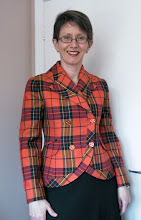 This shirt/jacket is about as hard to photograph as a black hole. I do hope it will be a useful garment in air conditioned offices and the like.
This shirt/jacket is about as hard to photograph as a black hole. I do hope it will be a useful garment in air conditioned offices and the like. This is McCalls 7365. It was a bit of a slog. There are 88 steps in the instructions, only a few of which are inapplicable to View C which is the one I made.
This is McCalls 7365. It was a bit of a slog. There are 88 steps in the instructions, only a few of which are inapplicable to View C which is the one I made.I fell for the complex lines of this shirt, which are of course all revealed by the sheer white fabric McCalls chose for it. Mine on the other hand is embroidered black linen, very lightweight but still... linen. From deep stash of course.
I made size 10 but think it's a bit too big on me.
 |
| Inside |
 |
| Outside |

I love this style of safari jacket. It casual but classy. Yours is perfect and I am sure you will wear it a lot.
ReplyDeleteIsn't that why a lot of us sew? Because what we create (even the insides) makes us strangely happy.
ReplyDeletePretty fantastic! Love it in black...great transitional piece!
ReplyDeleteSüper bir iş. Ellerinize sağlık.
ReplyDeleteYou are so amazing how much you accomplish. Beautiful work as always!
ReplyDeleteDoesn't look too big on you, to me -- but then I live in a hot climate and never want fabric to touch my body in the summertime.
ReplyDeleteIt is easier than easy to do a French seam when you insert a sleeve in the round. First, pin/baste the sleeve in, wrong side to wrong side. Sew your first pass (however much of a tiny seam allowance you normally give yourself when sewing a French seam). Then, trim the seam. Turn sleeve out so right side is against right side. Press (I finger-press at this stage) and pin/baste the sleeve. Sew the second pass, which encloses the raw edges inside the finished seam. Turn and press. Ta da! This took longer to write than it does to sew in the sleeve.
Love safari jackets and think yours looks very nice on you. I wish they were easier to make. I really appreciate LinB's comments on how to do a French seam when inserting a sleeve. I've always wondered about that.
ReplyDeleteMiz Mary, honey, I never in my long long life even thought about sewing French seams for sleeves. Common wisdom when I learned to sew was that you can never use that seam finish on curves seams. Pshaw! I laugh at convention, when convention is silly. Otherwise, I am ultra-conventional.
DeleteI first puzzled this out for myself after reading in Amanda's Adventures in Sewing, over and over, that she had put in her sleeves with French seams.
It's a secure finish. Not that easy to alter, though -- so I DO baste in my sleeves on the regular seam allowance, and try on the garment (inside-out, naturally) to be certain that the fit is what I want. I have a forward shoulder, so the way I position my sleeves is not necessarily how a pattern designer intended the sleeves to go in the armscye.
Picking out stitches on two passes around a sleeve, then re-setting it with a tiny seam allowance, is not for the faint of heart. Good thing that I exercise regularly and closely monitor my intake of fat.
You've really done a beautiful job, as always. I like the material you choose for a rather masculine style of a jacket, and perfect for a cover up in the air conditioning, but not too hot. Also perfect for our cooler evenings in August.
ReplyDelete88 steps, ouuieeee,,,congrats on such a lovely garment.
Joyce from Sudbury ( seamsalright)
Great looking jacket! Safari style jackets never seem to go out of fashion so I'm sure you will be years of wear out of this one. I don't think it looks to big on you either.
ReplyDeleteI love the jacket! It is a bit over-sized, but only a small bit, and it suits both the style of the pattern and your overall frame-it is not sloppy or baggy. LOL-black clothes are almost IMPOSSIBLE to photograph well, aren't they?
ReplyDelete